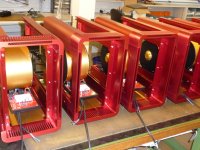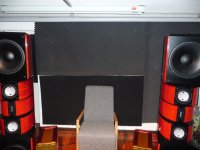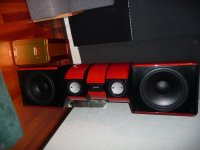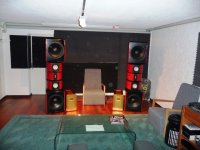You are using an out of date browser. It may not display this or other websites correctly.
You should upgrade or use an alternative browser.
You should upgrade or use an alternative browser.
Do you prefer SS or tube? Why?
- Thread starter bluegrassphile
- Start date
Regarding your comment about the clipping, the means to clipping is that the source can't be trusted to put out only 1 volt. Since all Redbook sources put out more than that, we have to assume that the 'source' is analog... If so it could easily be making more than 2 volts or more on peaks, even if its supposed to only put out one volt at reference level. Of course if we are only playing sine waves then of course you are correct, but I for one don't know any audiophiles that play sine waves for any length of time.
Sure it can.
If it's a DAC direct setup in which you know the output level at 0dBFS you attenuate the signal in dBs until it won't go over the input sensitivity of the amplifier. Or if the DAC has selectable reference output levels set in the analog domain, like in my case, you just select an output level that is lower than the input sensitivity of the amplifier. This way you're not clipping the amplifier.
And even if you're using a preamp it's easy to measure its output at different volume steps to see at what point you have the level over the input sensitivity of the amplifier. This way you avoid clipping the amplifier.
If you don't get enough SPL in these situations then it means you need a more powerful amplifier.
a.wayne
Well-known member
Haha, ha , Priceless ..... 
Sure it can.
If it's a DAC direct setup in which you know the output level at 0dBFS you attenuate the signal in dBs until it won't go over the input sensitivity of the amplifier. Or if the DAC has selectable reference output levels set in the analog domain, like in my case, you just select an output level that is lower than the input sensitivity of the amplifier. This way you're not clipping the amplifier.
And even if you're using a preamp it's easy to measure its output at different volume steps to see at what point you have the level over the input sensitivity of the amplifier. This way you avoid clipping the amplifier.
If you don't get enough SPL in these situations then it means you need a more powerful amplifier.
I don't have much techie EE credentials here, but I can tell you that years ago I was at Dartzeels house in the Basement demo room until 1am and we were playing loud, like perhaps 90db average. We played Chie Ayado's Tennessee Waltz (female vocals and piano) and his NHB-458 mono-blocs (with instant wattage readout LEDs) peaked at 1007watts! They were often above 700w.
We all know that female voice and piano are among the most stressful signals for amplfiers to receive, so this tells me that clipping is more common that we assume. Of course with tubes and soft clipping SS circuits, it is less noticeable by ear...but clearly very real as shown by those brute amps (~$140K a pair).
Attachments
90dB average is indeed very loud, this means you could have 110dB peaks.
If the amps were really outputing over 1000W (don't know how accurate their meter is) it means they were also clipping a lot since Stereophile measurements show them to clip at 500W into 8Ohm. The speakers look like the EA MMThree which have powered woofers and are 7 Ohm/93dB for the passive part with 400W power handling. Hard to believe there were over 1000W put just into those two midrange units and tweeters without them melting away even for short peaks.
The clipping might have been masked by the high SPL as well.
My point is not that nobody needs high power amplifiers, but that the required power needs to be assesed based on the specific situation of the listener. I listen at about 70-75dB average with peaks barely going over 90dB so I don't need hundreds of W.
If the amps were really outputing over 1000W (don't know how accurate their meter is) it means they were also clipping a lot since Stereophile measurements show them to clip at 500W into 8Ohm. The speakers look like the EA MMThree which have powered woofers and are 7 Ohm/93dB for the passive part with 400W power handling. Hard to believe there were over 1000W put just into those two midrange units and tweeters without them melting away even for short peaks.
The clipping might have been masked by the high SPL as well.
My point is not that nobody needs high power amplifiers, but that the required power needs to be assesed based on the specific situation of the listener. I listen at about 70-75dB average with peaks barely going over 90dB so I don't need hundreds of W.
Haha, ha , Priceless .....
Do you have anything of value to add or just moronic one-liners as usual?
Anatta you're post makes my head hurt. But you now admit to clipping so how does one allow for dynamic increases of 8 dB ? How does one show the needed headroom for large dynamic jumps needed way above just 8 dB. When I had my 04 amp even after modding the caps the clipping became obvious at low levels.
a.wayne
Well-known member
Do you have anything of value to add or just moronic one-liners as usual?
Im trying to find your communicating sweet spot
Seeing how you cant grasp basic academic EE .. BTW how much distortion is too much, you never answered,
obfuscate away ...!
a.wayne
Well-known member
90dB average is indeed very loud, this means you could have 110dB peaks.
If the amps were really outputing over 1000W (don't know how accurate their meter is) it means they were also clipping a lot since Stereophile measurements show them to clip at 500W into 8Ohm. The speakers look like the EA MMThree which have powered woofers and are 7 Ohm/93dB for the passive part with 400W power handling. Hard to believe there were over 1000W put just into those two midrange units and tweeters without them melting away even for short peaks.
The clipping might have been masked by the high SPL as well.
My point is not that nobody needs high power amplifiers, but that the required power needs to be assesed based on the specific situation of the listener. I listen at about 70-75dB average with peaks barely going over 90dB so I don't need hundreds of W.
look up amplifier headroom and dynamic power ..... !
BTW how much distortion is too much, you never answered,
Depends on how clean your ears are.
look up amplifier headroom and dynamic power ..... !
I will if you answer on how you clip the amplifier if you keep the input signal at a lower level than the one required by the amplifier to reach full power.
Dr Morbius
Active member
- Joined
- Jun 14, 2016
- Messages
- 205
To get back to the original question, I guess I still find tubes win out for ultimate organic sound, as long as you have efficient speakers.
The Deforest family recently revealed a secret cache of Lee Deforest’s final papers. Substantively, he revealed profit as his only motive for marketing a substandard device, the tube. He apologized to future generations, concluding that he simply wouldnt last financially when transistors made it from theory to reality
a.wayne
Well-known member
To get back to the original question, I guess I still find tubes win out for ultimate organic sound, as long as you have efficient speakers.
Can agree with this , its load first , (Speakers ) then amps for the load when selecting ..
Jean Sibelius
New member
From a musical perspective I like tube amplifiers better, but only if they do not have the 'typical'disadvantages of the less well designed ones. If you prefer extreme control or extreme dynamics, SS is the way to go. With my current tube amplifiers I found something that combines the best of both worlds for me.
bluegrassphile
Member
- Thread Author
- #215
If I could only own one or the other.....SS.
Dr Morbius
Active member
- Joined
- Jun 14, 2016
- Messages
- 205
Hey Samoyed, if you want to buy a bridge, I got a nice one for you..........how far are you from Brooklyn?
Tube rectifiers have a inherent problem with overvoltage over a period. The system maybe subject to small overvolts from time to time, however collectively over a long period, the problem starts to breakdown over the tube.
Solid state rectifiers can take a beating day in and day out and suffer none of these effects, the price difference between a 400V and 1600V rectifier is trivial.
Solid state rectifiers can take a beating day in and day out and suffer none of these effects, the price difference between a 400V and 1600V rectifier is trivial.




